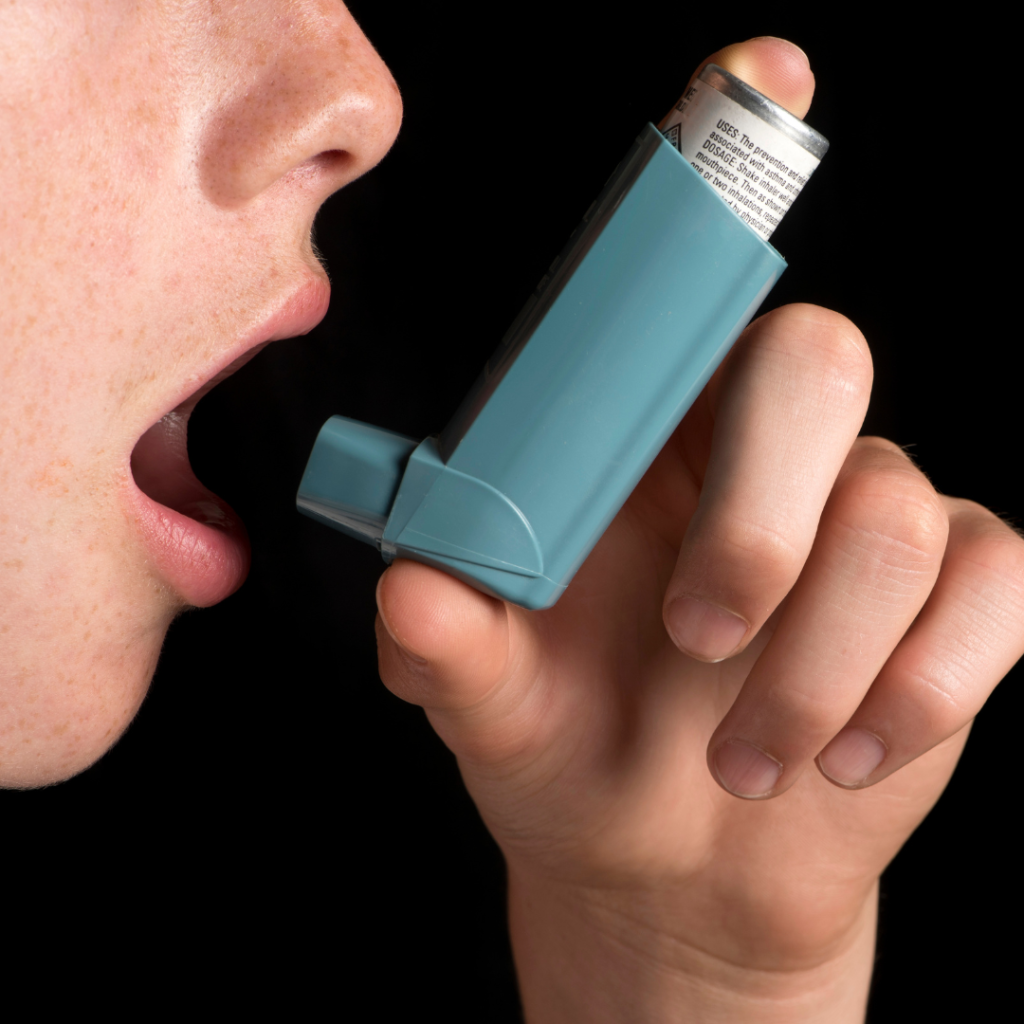小兒氣喘用藥指南:類固醇、支氣管擴張劑怎麼用?
小朋友咳嗽咳不停,總是讓人擔心!尤其是有氣喘的小朋友,更需要特別注意用藥。根據台灣兒童過敏氣喘免疫及風濕病醫學會的統計,台灣兒童氣喘的盛行率約為15%,且有逐年上升的趨勢,顯示氣喘是兒童常見的呼吸道疾病。今天我們就來談談小兒氣喘的用藥指南,讓您更了解類固醇和支氣管擴張劑的使用方法。
治療小兒氣喘的主要藥物包括類固醇和支氣管擴張劑:
類固醇(Corticosteroids)
類固醇主要作用是抗發炎,減少呼吸道腫脹和發炎反應,能有效控制氣喘症狀。口服類固醇通常用於急性發作,吸入型類固醇則用於長期控制。
支氣管擴張劑(Bronchodilators)
支氣管擴張劑主要作用是放鬆呼吸道平滑肌,擴張支氣管,讓呼吸更順暢。常見的支氣管擴張劑有短效型和長效型兩種。短效型用於緩解急性症狀,長效型則用於長期控制。
不同年齡層的氣喘用藥策略
根據文獻,不同年齡層的小兒氣喘用藥策略有不同:台灣氣喘衛教學會針對五歲以下兒童氣喘的治療,特別強調由於嬰幼兒的症狀表現常缺乏特異性且變化多端,因此診斷需仰賴症狀的觀察,並積極鼓勵家長參與孩子的氣喘管理:
12歲以上兒童
可考慮使用間歇性吸入型類固醇合併長效型支氣管擴張劑來治療輕度氣喘。
12歲以下兒童
目前尚無足夠證據支持間歇性吸入型類固醇合併長效型支氣管擴張劑的使用,因此建議維持既有的治療方式。
嬰幼兒
茶鹼(Theophylline) 是一種甲基黃嘌呤,曾被認為可用於緩解持續性氣喘,但其療效不如吸入型類固醇。若要使用茶鹼,需密切監控血中濃度,並注意藥物交互作用,例如與巨環類抗生素併用時可能需要減少劑量。
急性氣喘發作的用藥
當孩子氣喘急性發作時,需要迅速給予藥物緩解症狀:
短效型支氣管擴張劑
可透過霧化器或定量噴霧吸入器(搭配吸藥輔助器)給藥,能快速舒緩呼吸道痙攣。合併使用短效型支氣管擴張劑和異丙托溴銨(ipratropium bromide),在治療初期可改善生理狀況並降低住院率,但出院後不需持續使用。
全身性類固醇
類固醇能有效減輕發炎反應,縮短病程。早期使用類固醇有助於降低住院需求並改善氣喘症狀。口服類固醇在治療急性氣喘發作方面,與靜脈注射製劑具有相似的療效,因此對於沒有生命危險的氣喘病人來說,口服類固醇是可接受的替代方案。
吸入型類固醇
通常不用於急性發作,但有研究顯示,在急診後,在全身性類固醇的基礎上添加吸入型布地奈德(budesonide),可改善症狀並降低復發率。
硫酸鎂
靜脈注射硫酸鎂可以作為平滑肌鬆弛劑,已被證明可以降低住院率。
氧氣
血氧濃度維持在90%以上,有助於維持周邊組織的氧氣供應,並減少缺氧性肺血管收縮。
氣喘長期控制的用藥
長期控制氣喘的目標是減少發作頻率和嚴重程度,維持良好的肺功能和生活品質:
吸入型類固醇
是長期控制氣喘的首選藥物,能有效控制呼吸道發炎。根據台灣兒童過敏氣喘免疫及風濕病醫學會2023年的兒童氣喘治療指引,不再建議單獨使用短效支氣管擴張劑治療氣喘,而應及早開始使用含有吸入型類固醇的控制藥物,並規律每日使用,才能有效控制氣喘症狀並降低嚴重發作的風險。低劑量吸入型類固醇對於長期使用是安全有效的。
長效型支氣管擴張劑
可與吸入型類固醇合併使用,增強療效。
白三烯受體拮抗劑 (例如孟魯司特,montelukast)
可作為吸入型類固醇的輔助治療,尤其是在高劑量吸入型類固醇仍無法有效控制氣喘的情況下。
氣喘照護其他重要事項
氣喘是影響孩子一輩子的過敏性疾病,除了規律追蹤和接受治療,生活中也要注意許多事情:
規律用藥
即使沒有症狀,也要按照醫師指示規律用藥,才能有效控制氣喘。「媽寶補給站」,一個健康教育平台,提供關於兒童氣喘維持和緩解藥物使用的指導。該平台建議父母根據氣喘發作的時間和嚴重程度採取不同的策略。
例如﹔僅在感冒期間出現氣喘症狀的兒童可以使用維持性吸入劑兩週;有季節性或持續性症狀的兒童可能需要長期或持續使用維持性藥物,並強調使用支氣管擴張劑作為緩解藥物,並指導正確使用方法以及監測症狀以調整治療計劃的重要性。
正確用藥技巧
正確使用吸入器非常重要,請務必請教醫師或藥師示範正確的吸入技巧。
避免誘發因子
避免接觸塵蟎、花粉、寵物毛屑、空氣污染等,可以減少氣喘發作的機會。知名作家和音樂人張曼娟,曾公開分享了她因嚴重氣喘而癱倒在床上的經歷,突顯了氣喘對日常生活的影響,以及需要及時和適當的醫療照護來管理這種疾病。
定期追蹤
定期回診追蹤,讓醫師評估病情和調整用藥。
病人教育
氣喘病人及其家屬需要了解氣喘的相關知識,才能做好自我管理,提高治療的成功率。著名的「3金歌王」殷正洋,也曾多次因氣喘症狀而面臨演唱危機。幾年前,在上海演唱時,他曾經因氣喘發作而陷入危急狀態。然而,通過熱愛打羽毛球的運動,殷正洋的體力和抵抗力明顯改善,他表示運動後很少感冒,也不易生痰,這讓他能夠繼續高歌。根據鄭志賢醫師的說明,過敏原和病毒是誘發氣喘的兩大主要原因,殷正洋的經歷表明適當的運動和預防措施對控制氣喘非常重要。
實務上的用藥觀察
研究顯示,在實際的兒科門診中,支氣管擴張劑、抗生素和口服類固醇是治療兒童咳嗽最常見的藥物。
支氣管擴張劑
較常開立給有發燒、鼻塞、喘鳴,以及過去有氣喘、肺炎或吞嚥困難病史的兒童。
抗生素
較常開立給年紀較大、咳嗽有痰、有鼻竇炎、肺炎或吞嚥困難病史,以及咳嗽時間較長的兒童。
口服類固醇
較常開立給年紀較小、咳嗽沒有痰,以及有氣喘或吞嚥困難病史的兒童。
持續更新的治療指引
氣喘治療指引會根據最新的研究證據不斷更新。例如,新的指引建議,五歲及以上,使用階梯式療法3~4級的所有病人,現在建議使用單一維持和緩解療法(SMART),而建議在階梯式療法第2級的病人,使用短效乙二型交感神經刺激劑搭配間歇性吸入皮質類固醇(ICS),以減輕症狀負擔、改善控制並最大限度地減少ICS總劑量。
結語
小兒氣喘的治療需要根據個別孩子的年齡、症狀嚴重程度和病史來制定個人化的治療計劃。請務必與您的兒科醫師討論,選擇最適合孩子的治療方案。切勿自行調整藥物劑量或停藥,以免影響治療效果。
Reference
[1] Management of Asthma in the Preschool Child. /Immunology and allergy clinics of North America /2019 LINK
[2] Managing childhood allergies and immunodeficiencies during respiratory virus epidemics The 2020 COVID19 pandemic﹔ A statement from the EAACIsection on pediatrics. /Pediatric allergy and immunology ﹔ official publication of the European Society of Pediatric Allergy and Immunology /2020 LINK
[3] COVID19 and Pediatric Asthma﹔ Clinical and Management Challenges. /International journal of environmental research and public health /2021 LINK
[4] Controversies in the treatment of mild asthma. What novelties and practical implications? /Pediatric allergy and immunology ﹔ official publication of the European Society of Pediatric Allergy and Immunology /2022 LINK
[5] Management of Asthma in the Preschool Child. /Immunology and allergy clinics of North America /2019 LINK
[6] Pediatric asthma﹔ Principles and treatment. /Allergy and asthma proceedings /2019 LINK
[7] Oral corticosteroids and asthma in children﹔ Practical considerations. /Pediatric allergy and immunology ﹔ official publication of the European Society of Pediatric Allergy and Immunology /2020 LINK
[8] Interventions for escalation of therapy for acute exacerbations of asthma in children﹔ an overview of Cochrane Reviews. /The Cochrane database of systematic reviews /2020 LINK
[9] Management of Asthma in the Preschool Child. /Immunology and allergy clinics of North America /2019 LINK
[10] Pediatric asthma﹔ Principles and treatment. /Allergy and asthma proceedings /2019 LINK
[11] The infant and toddler with wheezing. /Allergy and asthma proceedings /2019 LINK
[12] Which Wheezing Preschoolers Should be Treated for Asthma? /The journal of allergy and clinical immunology. In practice /2021 LINK
[13] Pediatric asthma﹔ Principles and treatment. /Allergy and asthma proceedings /2019 LINK
[14] Nebulized Inhaled Corticosteroids in Asthma Treatment in Children 5 Years or Younger﹔ A Systematic Review and Global Expert Analysis. /The journal of allergy and clinical immunology. In practice /2020 LINK
[15] Interventions for escalation of therapy for acute exacerbations of asthma in children﹔ an overview of Cochrane Reviews. /The Cochrane database of systematic reviews /2020 LINK
[16] The effects of nebulized ketamine and intravenous magnesium sulfate on corticosteroid resistant asthma exacerbation; a randomized clinical trial. /Asthma research and practice /2021 LINK
[17] Management of Asthma in the Preschool Child. /Immunology and allergy clinics of North America /2019 LINK
[18] Pediatric asthma﹔ Principles and treatment. /Allergy and asthma proceedings /2019 LINK
[19] Asthma maintenance and reliever therapy﹔ Should this be the standard of care? /Annals of allergy, asthma & immunology ﹔ official publication of the American College of Allergy, Asthma, & Immunology /2020 LINK
[20] Longterm effectiveness and safety of omalizumab in pediatric and adult patients with moderatetosevere inadequately controlled allergic asthma. /The World Allergy Organization journal /2022 LINK
[21] Schoolbased selfmanagement interventions for asthma in children and adolescents﹔ a mixed methods systematic review. /The Cochrane database of systematic reviews /2019 LINK
[22] EAACI Guidelines on the effective transition of adolescents and young adults with allergy and asthma. /Allergy /2020 LINK
[23] Primary prevention of asthma﹔ from risk and protective factors to targeted strategies for prevention. /Lancet (London, England) /2020 LINK
[24] A practical toolbox for the effective transition of adolescents and young adults with asthma and allergies﹔ An EAACI position paper. /Allergy /2022 LINK
[25] Pediatric asthma﹔ Principles and treatment. /Allergy and asthma proceedings /2019 LINK
[26] Oral corticosteroids and asthma in children﹔ Practical considerations. /Pediatric allergy and immunology ﹔ official publication of the European Society of Pediatric Allergy and Immunology /2020 LINK
[27] Interventions for escalation of therapy for acute exacerbations of asthma in children﹔ an overview of Cochrane Reviews. /The Cochrane database of systematic reviews /2020 LINK
[28] Antibiotic therapy versus no antibiotic therapy for children aged 2 to 59 months with WHOdefined nonsevere pneumonia and wheeze. /The Cochrane database of systematic reviews /2021 LINK
[29] Single inhaler maintenance and reliever therapy in pediatric asthma. /Current opinion in allergy and clinical immunology /2019 LINK
[30] Asthma maintenance and reliever therapy﹔ Should this be the standard of care? /Annals of allergy, asthma & immunology ﹔ official publication of the American College of Allergy, Asthma, & Immunology /2020 LINK
[31] New approach to intermittent and mild asthma therapy﹔ evolution or revolution in the GINA guidelines? /Clinical and translational allergy /2020 LINK
[32] A Practical Guide to Implementing SMART in Asthma Management. /The journal of allergy and clinical immunology. In practice /2022 LINK
